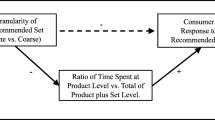Abstract
Recent findings suggest that while shopping people apply ‘fast and frugal’ heuristics: short-cut strategies where they ignore most product information and instead focus on a few key cues. But rather than supporting this practice, mobile phone shopping apps and recommender systems overwhelm shoppers with information. This paper examines the amount and structure of product information that is most appropriate for supermarket shoppers, finding that in supermarkets, people rapidly make decisions based on one or two product factors for routine purchases, often trading-off between price and health. For one-off purchases, shoppers can be influenced by reading customer star ratings and reviews on a mobile phone app. In order to inform decision-making or nudge shoppers in supermarkets, we propose using embedded technologies that provide appropriate feedback and make key information salient. We conclude that rather than overwhelming shoppers, future shopping technology design needs to focus on information frugality and simplicity.








Similar content being viewed by others
References
Black D, Clemmensen NJ, Skov MB (2009) Supporting the supermarket shopping experience through a context-aware shopping trolley. In: Proceedings of the 21st annual conference of the Australian Computer-Human Interaction Special Interest Group, ACM Press, pp 33–40
EDS IDG Shopping Report (2007) Shopping choices: attraction or distraction? http://www.eds.com/industries/cir/downloads/EDSIDGReport_aw_final.pdf. Retrieved 17 Feb 2011
Gaver W, Dunne T, Pacenti E (1999) Cultural probes. Interactions 6(1):21–29
Goldstein DG, Gigerenzer G (2002) Models of ecological rationality: the recognition heuristic. Psychol Rev 109:75–90
GoodGuide. http://www.goodguide.com/. Retrieved 17 Feb 2011
Goodman J, Brewster S, Gray P (2004) Using field experiments to evaluate mobile guides. In: Schmidt-Belz B, Cheverst K (eds) Proceedings of HCI in mobile guides, workshop at mobile HCI 2004. Springer, Glasgow, pp 38–48
GoogleShopper. http://www.google.com/mobile/shopper/. Retrieved 17 Feb 2011
Iyengar S (2010) The art of choosing: the decisions we make everyday of our lives, what they say about us and how can improve them. Little, Brown
Jain J, Ghosh R, Dekhil M (2009) Multimodal shopping lists. In: Proceedings of HCI’09. Springer, Berlin, Heidelberg, pp 39–47
Kahl G, Spassova L, Schöning J, Gehring S, Krüger A (2011) IRL SmartCart—a user-adaptive context-aware interface for shopping assistance. In: Proceedings of IUI’11, ACM Press, pp 359–362
Kallehave O, Skov MB, Tiainen N (2011) Persuasion in situ: shopping for healthy food in supermarkets. In: Proceedings of PINC 2011 workshop at CHI
Kalnikaitė V, Rogers Y, Bird J, Villar N, Bachour K, Payne S, Todd MP, Schoning J, Kruger A, Kreitmayer S (2011) How to nudge in situ: designing lambent devices to deliver salient information in supermarkets. In: Proceedings of 13th international conference on Ubiquitous computing (UbiComp’11), ACM Press, pp 11–20
Katsikopoulos KV, Fasolo B (2006) New tools for decision analysts. IEEE Syst Man Cybern A 36:960–967
Kjeldskov J, Skov MB, Als BS, Høegh RT (2004) Is it worth the hassle? Exploring the added value of evaluating the usability of context-aware mobile systems in the field. In: Proceedings of mobile HCI 2004, pp 61–73
Lewis CH (1982) Using the “thinking aloud” method in cognitive interface design. Technical report IBM RC-9265
Macphail S (2011) GE money survey? http://www.dailymail.co.uk/femail/article-419077/Women-spend-years-life-shopping.html. Retrieved 17 Feb 2011
National Heart Forum (2007) Misconceptions and misinformation: The problems with guideline daily amounts. http://nhfshare.heartforum.org.uk/RMAssets/Reports/NHFGDAreport.pdf. Retrieved 17 Feb 2011
Nurmi P, Lagerspetz E, Buntine W, Floréen P, Kukkonen SJ (2008) Product retrieval for grocery stores. In: Proceedings of the SIGIR’08, ACM Press, pp 781–782
OpenIdeo (2011) Shopping cart provokes healthier purchases. http://openideo.com/open/how-might-we-give-children-the-knowledge-to-eat-better/winner-announced/shopping-cart-provokes-healthier-purchases/. Retrieved 28 Oct 2011
Payne JW, Bettman JR, Johnson EJ (1993) The adaptive decision making. Cambridge University Press, Cambridge
RedLaser. http://redlaser.com/. Retrieved 17 Feb 2011
Reischach F, Guinard D, Michahelles F, Fleisch E (2009) A mobile product recommendation system interacting with tagged products. In: Proceedings of the 7th conference on pervasive computing and communications, ACM Press, pp 1–6
Resatsch F, Karpischek S, Sandner U, Hamacher S (2007) Mobile sales assistant: NFC for retailers. In: Proceedings of mobile HCI’07, ACM Press, pp 313–316
Resatsch F, Sandner U, Leimeister JM, Krcmar H (2008) Do point of sale RFID-based information services make a difference? analyzing consumer perceptions for designing smart product information services in retail business. Electron Mark 18(3):216–231
Rogers Y, Hazelwood W, Marshall P, Dalton NS, Hertrich S (2012) Ambient influence: can twinky lights lure and abstract representations trigger behavioural change? In: Proceedings of Ubicomp’10. ACM Press, pp 261–270
Shekar S, Nair P, Helal A (2003) iGrocer: a ubiquitous and pervasive smart grocery shopping system. In: Proceedings of SAC ‘03. ACM Press, pp 645–652
Steptoe A, Pollard TM, Wardle J (1995) Development of a measure of the motives underlying the selection of food: the food choice questionnaire. Appetite 25:267–284
The Eatery by Massive Health. http://massivehealth.com/. Retrieved 4 Nov 2011
Time Use Institute Grocery Shopping: Who, Where and When (2008). http://www.timeuseinstitute.org/Grocery%20White%20Paper%202008.pdf. Retrieved 17 Feb 2011
Todd PM, Miller GF (1999) From pride and prejudice to persuasion: Satisfying in mate search. In: Gigerenzer G, Todd PM, The ABC Research Group (eds) Simple heuristics that make us smart. Oxford University Press, New York, pp 287–308
Todd PM, Gigerenzer G (2007) Environments that make us smart: ecological rationality. Curr Dir Psychol Sci 16(3):167–171
Todd PM, Rogers Y, Payne SJ (2011) Nudging the trolley in the supermarket: how to deliver the right information to shoppers. J Mobile HCI (to appear)
UK Food Standards Agency. http://www.eatwell.gov.uk/foodlabels/labellingterms/nutritionalinfo/. Retrieved 17 Feb 2011
UK Food Standards Agency—Low income diet and nutrition survey. http://www.food.gov.uk/science/dietarysurveys/lidnsbranch/#h_3. Retrieved 17 Feb 2011
UK Shopping Habits Survey. http://www.gemoney.co.uk/. Retrieved 17 Feb 2011
Underhill P (2009) Why we buy: the science of shopping. Simon and Schuster, New York
von Reischach F, Michahelles F, Schmidt A (2009) The design space of ubiquitous product recommendation systems. In: Proceedings of MUM’09, ACM Press, Article 2
von Reischach F, Dubach E, Michahelles F, Schmidt A (2010) An evaluation of product review modalities for mobile phones. In: Proceedings of mobile HCI’10, ACM Press, pp 199–208
Which report, Making sustainable food choices easier (2010). http://www.which.co.uk/documents/pdf/making-sustainable-food-choices-easier-231317.pdf. Retrieved 17 Feb 2011
Wu H, Natchetoi Y (2007) Mobile shopping assistant: integration of mobile applications and web services. In: Proceedings of WWW’07, ACM Press, pp 1257–1260
Zaichkowsky JL (1985) Measuring the involvement construct. J Consumer Res 12:341–352
Acknowledgments
The research is partially funded by the EPSRC grant “CHANGE: Engendering Change in People’s Everyday Habits Using Ubiquitous Computing Technologies” (number XC/09/043/YR). We would like to thank our collaborators Nicolas Villar, Khaled Bachour, Stephen Payne, Peter M. Todd, Johannes Schöning, Antonio Krüger and Stefan Kreitmayer, all of whom have helped with the design and evaluation of the lambent shopping handle. We also thank our participants for coming shopping with us.
Author information
Authors and Affiliations
Corresponding author
Rights and permissions
About this article
Cite this article
Kalnikaitė, V., Bird, J. & Rogers, Y. Decision-making in the aisles: informing, overwhelming or nudging supermarket shoppers?. Pers Ubiquit Comput 17, 1247–1259 (2013). https://doi.org/10.1007/s00779-012-0589-z
Received:
Accepted:
Published:
Issue Date:
DOI: https://doi.org/10.1007/s00779-012-0589-z




